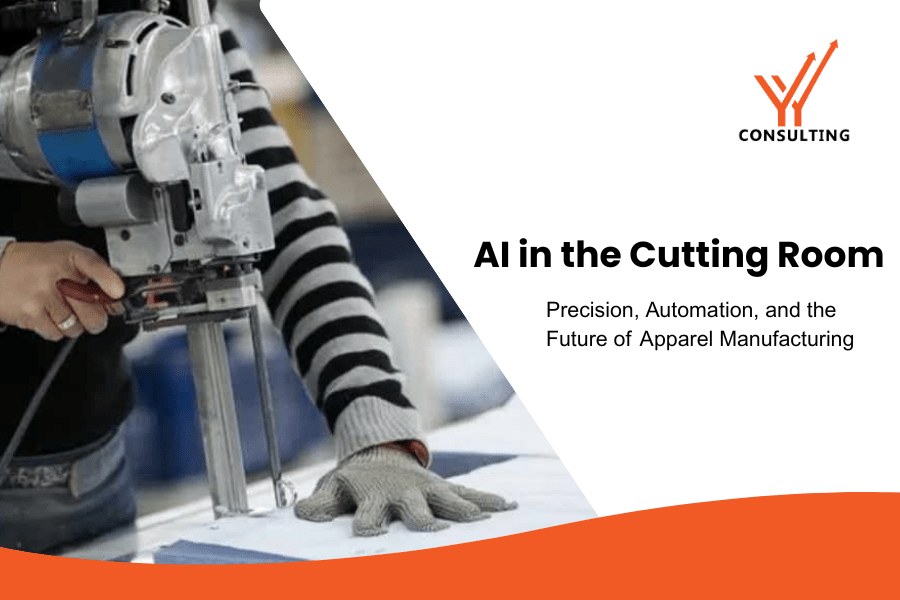Introduction
In the fast-evolving landscape of apparel manufacturing, the cutting room holds a decisive yet often underappreciated role. While design sparks creativity and sewing brings garments to life, it is in the cutting room where profitability is truly determined. With fabric accounting for nearly 50–70% of the total garment cost, even minor inefficiencies in planning or execution can translate into massive financial losses.
Traditionally, cutting has relied on human judgment and CAD-based systems. However, the apparel industry now stands at the brink of a transformative leap: the integration of Artificial Intelligence (AI) into cutting operations. Algorithms, predictive planning, and real-time optimization are redefining how manufacturers save fabric, reduce waste, and ultimately improve margins.
The Cutting Room Challenge
The cutting room is where precision meets scale. A miscalculation in marker planning, excess fabric buffer, or unchecked fabric defect can cascade into waste, inflated costs, and missed delivery timelines.
Some of the most common challenges include:
- Manual Lay Planning: Human planners often fail to maximize marker efficiency, leaving significant fabric unused.
- Inaccurate Consumption Estimates: Traditional systems rely on fixed assumptions, leading to over-ordering of fabric to cover risk.
- Defects and Re-cuts: Without proper defect mapping, flawed fabric pieces end up in the marker, requiring rework.
- Inefficient Scheduling: Poor sequencing of cutting operations leads to idle time, machine under-utilization, and higher turnaround times.
The cumulative impact is not only higher costs but also reduced competitiveness, especially in today’s buyer-driven market where every percentage point of margin counts.
Artificial Intelligence in Cutting Room
AI brings a new dimension to cutting room efficiency by combining data-driven insights with predictive intelligence. Unlike traditional CAD or CAM tools, which largely assist with drawing and nesting, AI systems learn from data over time—factoring in fabric variations, order histories, machine performance, and operator patterns.
The result? Smarter decisions, optimized resource utilization, and reduced dependency on human guesswork. Where CAD improves accuracy, AI transforms the process into a continuous cycle of learning and optimization.
Key Applications of AI in Cutting Rooms
- AI-Powered Lay Planning
Conventional lay planning seeks to fit patterns onto fabric with minimal waste. AI takes this a step further by analyzing thousands of marker scenarios in seconds, factoring in fabric width, shrinkage, defect locations, and production priorities.
- Achieves up to 3–5% fabric savings compared to traditional methods.
- Enables planners to run simulations across multiple orders simultaneously.
- Real-Time Consumption Prediction
Factories typically order fabric with an added buffer of 3–5% to avoid shortfalls. AI algorithms refine consumption prediction using historical data and machine learning models, ensuring near-exact ordering.
- Reduces excess procurement, cutting raw material costs.
- Provides accurate order-level consumption reports for better buyer communication.
- Defect Mapping & Smart Cutting
With AI-enabled vision systems, fabric defects are mapped in real-time during the spreading process. The system dynamically adjusts markers to avoid defect zones without wasting entire fabric sections.
- Minimizes re-cuts and rejections.
- Ensures consistent quality with less manual inspection effort.
- Dynamic Scheduling and Workflow Optimization
AI optimizes the sequencing of cutting tasks based on machine availability, order priority, and delivery timelines.
- Improves machine utilization by 10–15%.
- Reduces idle time and accelerates turnaround for fast-fashion cycles.
Tangible Business Impact
The benefits of embedding AI into cutting rooms are measurable and multi-dimensional:
- Fabric Savings: Even a 1% improvement in fabric utilization can save hundreds of thousands of dollars annually in medium-to-large factories.
- Margin Improvement: AI-driven planning directly impacts gross margin by lowering the largest cost component—fabric.
- Operational Efficiency: Faster marker planning and defect avoidance reduce bottlenecks, enabling higher throughput.
- Sustainability Gains: Less waste means fewer resources consumed and lower emissions from fabric production and disposal.
In short, AI in the cutting room is not just about cost reduction—it is about building smarter, greener, and more competitive supply chains.
Case Study: EverLighten — AI-Powered Nesting for Efficiency and Waste Reduction
EverLighten, a small-scale garment manufacturer and custom apparel brand, faced a common challenge in its cutting operations: high fabric waste (up to 15%), slow production due to manual nesting, and rising labor costs. For a company working with tight margins, these inefficiencies directly threatened profitability.
The AI Solution
In 2024, EverLighten adopted AI-powered nesting and cutting technology. The system used intelligent algorithms to automatically arrange garment patterns on fabric in the most space-efficient way. Unlike traditional methods that relied on trial-and-error or semi-manual CAD layouts, the AI-driven system ensured real-time optimization, precision, and speed.
Key capabilities included:
- Automated pattern placement for maximum fabric utilization.
- Real-time defect avoidance and high-accuracy layouts.
- Faster order transitions through automated re-nesting.
Results Achieved
Within just six months of adoption, EverLighten recorded significant improvements:
- 25% reduction in fabric waste.
- 40% increase in production efficiency.
- Higher profit margins due to combined material and labor savings.
“AI nesting maximized every inch of fabric and reduced human error. What used to take hours can now be achieved in minutes—delivering both cost savings and faster delivery.” — EverLighten Blog
The Roadblocks to Adoption
While the promise of AI is clear, manufacturers face practical challenges:
- High Initial Investment: Cutting room digitization and AI integration require upfront capital, which smaller factories may hesitate to commit.
- Skill Gaps: Operators and planners need training to adapt from manual or semi-digital methods to AI-enabled systems.
- Integration Issues: Many factories already use ERP, PLM, or MES systems; seamless integration of AI solutions requires careful planning.
However, these barriers are short-term hurdles compared to the long-term gains. Industry leaders that invest early are already reaping benefits in cost savings, sustainability, and buyer trust.
The Future of AI in Cutting Rooms
The trajectory is clear: AI will be central to the autonomous cutting room of the future.
- Lights-Out Cutting Rooms: With AI integrated into cutting machines and robotic arms, factories can operate with minimal human intervention.
- IoT Integration: Sensors feeding real-time data into AI systems will enable predictive maintenance and continuous optimization.
- Connected Factories: AI-powered cutting rooms will link seamlessly with upstream design (PLM) and downstream sewing (MES), creating a closed-loop smart factory ecosystem.
Ultimately, the vision aligns with the broader dark factory mindset, where automation and intelligence deliver consistency, speed, and profitability—even in challenging cost environments.
Conclusion
For decades, the cutting room has been viewed as a cost center—necessary but often overlooked in strategic planning. Today, AI is rewriting that narrative. By embedding intelligence into lay planning, defect mapping, and scheduling, apparel manufacturers are transforming the cutting room into a profit and innovation center.
This is not merely an efficiency upgrade; it represents a strategic shift in how factories operate and compete. In an industry under relentless pressure from rising costs, fast-changing buyer expectations, and sustainability mandates, AI in the cutting room provides a clear path to resilience, profitability, and long-term competitiveness.
At Groyyo Consulting, we partner with apparel manufacturers across South Asia and beyond to make this shift a reality. Our team brings deep expertise in lean manufacturing, industrial engineering, digital transformation, and sustainability, helping factories bridge the gap between traditional operations and Industry 4.0 readiness. Whether it is diagnostic studies, cutting room optimization, or integrating AI-driven solutions into ERP and MES systems, we work closely with clients to unlock efficiency, reduce costs, and elevate global buyer confidence.
We see AI not just as a technology, but as a strategic enabler of smarter factories—factories that are greener, faster, and more agile. By combining our on-ground implementation experience with global best practices, Groyyo Consulting empowers manufacturers to reimagine their operations for the future.

Divya Mohan
General Manager (International Business)
divyamohan@groyyo.com


Leave a Comment